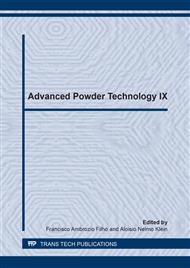p.46
p.51
p.56
p.61
p.66
p.72
p.78
p.84
p.90
Sintering of Al4C3 Using Aluminum Scrap and Commercial Graphite
Abstract:
In this works, aluminum scraps powders were mixed with commercial graphite and mechanically alloyed in a high-energy ball mill and subsequently powders sintering. The initial grinding of aluminum scraps for 2 hours and then mixed with commercial graphite powder at a proportion of (y)Al-(x)C (wt%) (x = 1, 5 e 10, 25). The mixture of aluminum and graphite powders was processed for a time at 5 hours of milling. The samples were sintered at a temperature of 750°C and 1000°C. Samples were analyzed by scanning electron microscopy and X-ray diffraction. The results of this study were to find important parameters of composition and sintering, because the increase in concentration of carbon in the aluminum indicates that the material may have different applications.
Info:
Periodical:
Pages:
66-71
Citation:
Online since:
December 2014
Authors:
Price:
Сopyright:
© 2014 Trans Tech Publications Ltd. All Rights Reserved
Share:
Citation:


